An altered chord is a seventh or extended chord in which the fifth note of the chord and/or an extension note — the ninth, 11th or 13th — is altered, either raised or lowered by a half step.
We begin our study of altered chords with an analysis of altered dominant chords.
This post will cover how to construct dominant chords with single alterations and provide examples for each type of chord.
It will also provide common fingerings for each chord, along with instruction on how to play them on a guitar with any root note.
Altered Dominant Chords
The most commonly altered dominant chords are:
- Dominant seventh, flat five.
- Dominant seventh, sharp five.
- Dominant seventh, flat nine.
- Dominant seventh, sharp nine.
- Dominant seventh, flat five, flat nine.
- Dominant seventh, sharp five, sharp nine.
- Dominant seventh, flat five, sharp nine.
- Dominant seventh, sharp five, flat nine.
Dominant Seventh, Flat Five Chords
If we lower the fifth scale degree of a dominant seventh chord, it becomes a dominant seventh, flat five chord.
The chord formula for a dominant seventh, flat five chord is: 1, 3, b5, b7.
A dominant seventh, flat five chord contains the first, third, flatted fifth and flatted seventh degrees of the major scale with the same root note:
- A C7(b5) chord contains the notes C, E, Gb and Bb — the first, third, flatted fifth and flatted seventh notes in a C major scale (fig.1a).
- An A7(b5) chord contains the notes A, C#, Eb and G — the first, third, flatted fifth and flatted seventh notes in an A major scale (fig.1b).
Fig.1
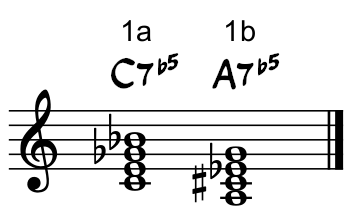
Dominant Seventh, Sharp Five Chords
If we raise the fifth scale degree of a dominant seventh chord, it becomes a dominant seventh, sharp five chord.
The chord formula for a dominant seventh, sharp five chord is: 1, 3, #5, b7.
A dominant seventh, sharp five chord contains the first, third, sharped fifth and flatted seventh degrees of the major scale with the same root note:
- A C7(#5) chord contains the notes C, E, G# and Bb — the first, third, sharped fifth and flatted seventh notes in a C major scale (fig.2a).
- An A7(#5) chord contains the notes A, C#, E# and G — the first, third, sharped fifth and flatted seventh notes in an A major scale (fig..2b).
Fig.2
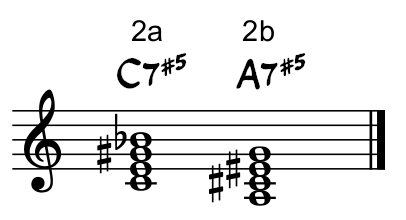
Dominant Seventh, Flat Nine Chords
If we lower the ninth scale degree of a dominant ninth chord (or add a flatted ninth scale degree to a dominant seventh chord), it becomes a dominant seventh, flat nine chord.
The chord formula for a dominant seventh, flat nine chord is: 1, 3, 5, b7, b9.
A dominant seventh, flat nine chord contains the first, third, fifth, flatted seventh and flatted ninth degrees of the major scale with the same root note:
- A C7(b9) chord contains the notes C, E, G, Bb and Db — the first, third, fifth, flatted seventh and flatted ninth notes in a C major scale (fig.3a).
- An A7(b9) chord contains the notes A, C#, E, G and Bb — the first, third, fifth, flatted seventh and flatted ninth notes in an A major scale (fig.3b).
Fig.3

Dominant Seventh, Sharp Nine Chords
If we raise the ninth scale degree of a dominant ninth chord (or add a sharped ninth scale degree to a dominant seventh chord), it becomes a dominant seventh, sharp nine chord.
The chord formula for a dominant seventh, sharp nine chord is: 1, 3, 5, b7, #9.
A dominant seventh, sharp nine chord contains the first, third, fifth, flatted seventh and sharped ninth degrees of the major scale with the same root note:
- A C7(#9) chord contains the notes C, E, G, Bb and D# — the first, third, fifth, flatted seventh and sharped ninth notes in a C major scale (fig.4a).
- An A7(#9) chord contains the notes A, C#, E, G and B# — the first, third, fifth, flatted seventh and sharped ninth notes in an A major scale (fig.4b).
Fig.4
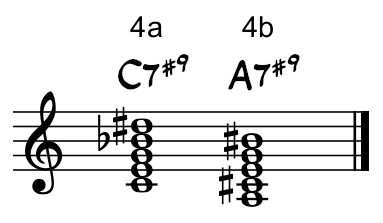
Summary of Altered Dominant Chord Formulas
The altered dominant chord formulas covered in this post are summarized below:
- Dominant seventh, flat five: 1, 3, b5, b7.
- Dominant seventh, sharp five: 1, 3, #5, b7.
- Dominant seventh, flat nine: 1, 3, 5, b7, b9.
- Dominant seventh, sharp nine: 1, 3, 5, b7, #9.
Chord Quality and Harmonic Function
The altered notes add color, texture and complexity to the seventh chords to which they are added. They don’t change the chord’s quality or harmonic function.
An altered dominant chord is still a dominant chord (containing a third and a flatted seventh note) and it still primarily functions as a V7 chord.
The altered note or notes do create greater dissonance or tension within the chord, intensifying the authentic cadence.
For example, the sound of an A7(b9) chord moving to a Dm chord is more dramatic than the sound of an A7 chord moving to the same Dm chord.
Omitted Notes
All of the notes in an altered chord formula don’t necessarily have to be included in any particular chord voicing. Some notes are less important than others and can be omitted.
The important notes that should always be included in an altered chord voicing are the chord’s third and seventh degrees, the highest extension note and any altered notes.
Root notes, the fifth scale degree and other extension notes are routinely left out of altered chord voicings on a guitar.
Altered Dominant Chords on a Guitar
Common fingerings and examples for the altered dominant chords covered in this post are provided below.
Dominant Seventh, Flat Five Chords
Fig.5 shows a common fingering for a dominant seventh, flat five chord.
Fig.5
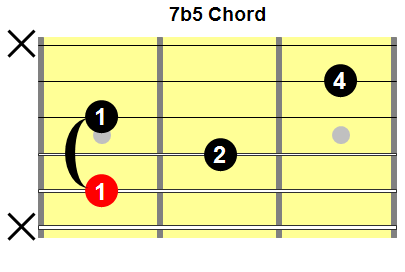
This fingering will allow you to play a dominant seventh, flat five chord with any root note:
- To play a C7(b5) chord, place the barre on the third fret (fig.6a).
- To play an A7(b5) chord, place the barre on the 12th fret (fig.6b).
Fig.6
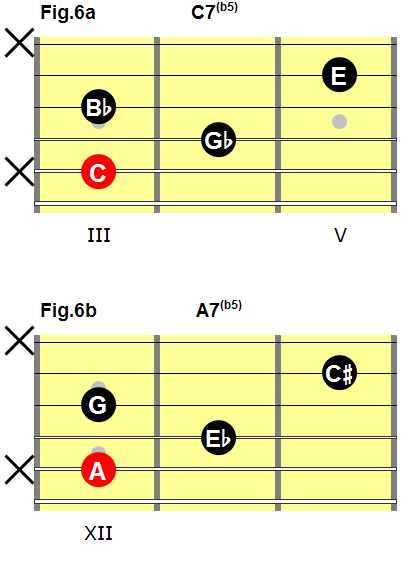
Dominant Seventh, Sharp Five Chords
Fig.7 shows a common fingering for a dominant seventh, sharp five chord.
Fig.7

This fingering will allow you to play a dominant seventh, sharp five with any root note:
- To play a C7(#5) chord, place your first finger on the C on the sixth string, eighth fret (fig.8a).
- To play an A7(#5) chord, place your first finger on the A on the sixth string, fifth fret (fig.8b).
Fig.8
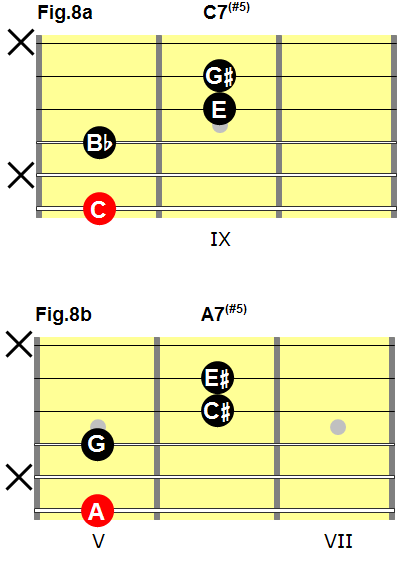
Dominant Seventh, Flat Nine Chords
Fig.9 shows a common fingering for a dominant seventh, flat nine chord.
Fig.9
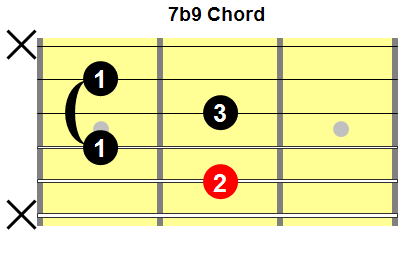
This fingering will allow you to play a dominant seventh, flat nine chord with any root note:
- To play a C7(b9) chord, place the barre on the second fret (fig.10a).
- To play an A7(b9) chord, place the barre on the 11th fret (fig.10b).
Fig.10
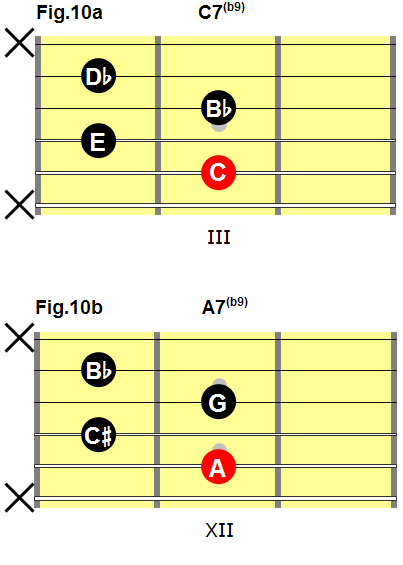
Dominant Seventh, Sharp Nine Chords
Fig.11 shows a common fingering for a dominant seventh, sharp nine chord.
Fig.11
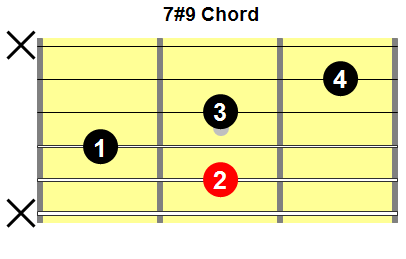
This fingering will allow you to play a dominant seventh, sharp nine chord with any root note:
- To play a C7(#9) chord, place your second finger on the C on the fifth string, third fret (fig.12a).
- To play an A7(#9) chord, place your second finger on the A on the fifth string, 12th fret (fig.12b).
Fig.12
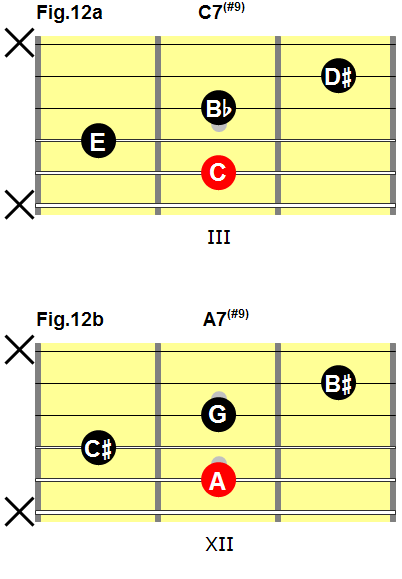
Chord Substitution
It’s common in jazz and other forms of music for a player to substitute an altered dominant chord for an unaltered dominant chord presented in the music.
The altered note or notes will serve to color the chord and create greater dissonance within it.
Related Posts
Related posts include:
- The Dominant Seventh Chord.
- Extended Chords I: Ninth Chords.
- Altered Dominant Chords II: Combined Alterations.
- Creating Chord Voicings I.
- Creating Chord Voicings II.
- The Dominant Diminished Scale.
- Soloing Over Altered Dominant Chords.
